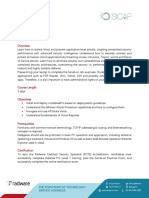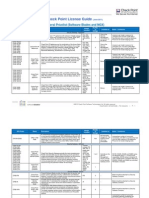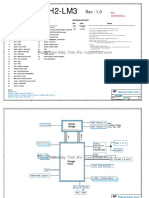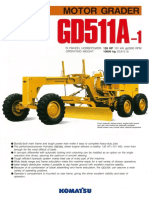Wireless Networks
Wireless Networks
Uploaded by
Natasha AgarwalCopyright:
Available Formats
Wireless Networks
Wireless Networks
Uploaded by
Natasha AgarwalOriginal Description:
Original Title
Copyright
Available Formats
Share this document
Did you find this document useful?
Is this content inappropriate?
Copyright:
Available Formats
Wireless Networks
Wireless Networks
Uploaded by
Natasha AgarwalCopyright:
Available Formats
Wireless Network
B.E. Sem. VIII [EXTC] EVALUATION SYSTEM Time 3 Hrs. SYLLABUS Objective: To understand the concept of wireless WAN, WAP and different IEEE standards. 1. Wide Area Wireless Networks (WANs) GSM Evolution Introduction, GSM evolution for data, Third-Generation (3G) Wireless Systems. UMTS Network Reference Architecture, Channel Structure in UMTS Terrestrial Radio Access Network, UMTS Terrestrial Radio Access Network Overview, UMTS Core Network Architecture, Adaptive Multi-Rate Codec for UMTS, UMTS Bearer Service, HSDPA. 2. Wide Area Wireless Networks (WANs) CDMA One Evolution Introduction, cdma2000 Layering Structure, Forward Link Physical Channels of cdma2000, Forward Link Features, Reverse Link Physical Channels of cdma2000. Evolution of cdmaOne (IS-95) to cdma2000, Technical Differences between cdma2000 and WCDMA. 3. Planning and Design of Wide Area Wireless Networks Introduction: Planning and Design of a Wireless Network, Radio Design for a Cellular Network, Receiver Sensitivity and Link Budget. 4. Wireless Application Protocol (WAP) Introduction, WAP and the World Wide Web (WWW) , Introduction to Wireless Application Protocol, The WAP Programming Model ,WAP Architecture, WAP Advantages and Disadvantages, Applications of WAP, imode, imode versus WAP. 5. Wireless Personal Area Network Bluetooth Introduction, The Wireless Personal Area Network, Bluetooth (IEEE 802.15.1), Definitions of the Terms Used in Bluetooth, Bluetooth Protocol Stack, Bluetooth Link Types, Bluetooth Security, Network Connection Establishment in Bluetooth, Network Topology in Bluetooth, Bluetooth Usage Models, Bluetooth Applications, WAP and Bluetooth Wireless Personal Area Networks (WPAN): Low Rate (LR) and High Rate (HR) Wireless Sensor Network, Usage of Wireless Sensor Networks, Wireless Sensor Network Model, Sensor Network Protocol Stack, ZigBee Technology, IEEE 802.15.4 LR-WPAN Device Architecture, IEEE 802.15.3a 0 Ultra WideBand, Radio Frequency Identification. 6. Wireless Local Area Networks (WLANs) WLAN Equipment, WLAN Topologies, WLAN Technologies, IEEE 802.11 WLAN Joining an Existing Basic Service Set, IEEE 802.11n, IEEE 802 16, World Interoperability for MicroAccess, Inc. (WiMAX). Marks 100 25 25
Theory Exam Practical Exam Oral Exam Term Work
Reference Books: 1. Wireless communication and Networking (Vijay Garg) ELSEVIER Inc. 2. Wireless Communication (Singal) TMH 3. Next Generation Wireless Systems and Networks (Hsiao Hwa Chen, Mohsen Guizani) Wiley. 4. Wireless and Mobile Networks-Concepts and protocols (Dr Sunilkumar S. Manvi, Mahabaleshwar S. Kakkasageri) Wiley. 5. Essentials of UMTS (Christopher Cox) Cambridge.
You might also like
- Gigabyte G1.Sniper H6 Rev 1.0Document36 pagesGigabyte G1.Sniper H6 Rev 1.0謝紳泳No ratings yet
- Lavelle Networks-Customer Presentation PDFDocument12 pagesLavelle Networks-Customer Presentation PDFRahul RajputNo ratings yet
- Pdo Guide To Engineering Standards and ProceduresDocument1 pagePdo Guide To Engineering Standards and ProceduresNavanitheeshwaran Sivasubramaniyam0% (1)
- Bangladesh Land Measurement ConversionDocument1 pageBangladesh Land Measurement ConversionIbrahim Al Harun100% (1)
- Mobile Computing Deployment and Management: Real World Skills for CompTIA Mobility+ Certification and BeyondFrom EverandMobile Computing Deployment and Management: Real World Skills for CompTIA Mobility+ Certification and BeyondNo ratings yet
- Ruckus Wireless 802 11u Hotspot 2 - 0 (v1)Document12 pagesRuckus Wireless 802 11u Hotspot 2 - 0 (v1)javierdb2012No ratings yet
- Wireless NetworksDocument11 pagesWireless NetworksMicah ThomasNo ratings yet
- Ruckus Design Best Practices v2Document19 pagesRuckus Design Best Practices v2Gley RaveloNo ratings yet
- PrplMesh An Open Source Implementation of The Wi Fi Alliance® Multi AP Specification Arnout Vandecappelle EssensiumMind PDFDocument37 pagesPrplMesh An Open Source Implementation of The Wi Fi Alliance® Multi AP Specification Arnout Vandecappelle EssensiumMind PDFIcaro PosdataNo ratings yet
- Cisco DNA Center Assurance 1.3 - Instant DemoDocument33 pagesCisco DNA Center Assurance 1.3 - Instant Demothelmo jarrinNo ratings yet
- Sicap 300-101 Defense Pro Level 1Document3 pagesSicap 300-101 Defense Pro Level 1Fiti HoyNo ratings yet
- CWNA Guide To Wireless LAN's Second Edition - Chapter 2Document46 pagesCWNA Guide To Wireless LAN's Second Edition - Chapter 2boytroy86No ratings yet
- HCIA-Datacom Training and Certification: (Huawei Certified ICT Associate - Datacom)Document1 pageHCIA-Datacom Training and Certification: (Huawei Certified ICT Associate - Datacom)ThjkuiNo ratings yet
- CCNP Quick Reference PDFDocument30 pagesCCNP Quick Reference PDFAditya BeheraNo ratings yet
- Chapter 2 Solutions: Review QuestionsDocument4 pagesChapter 2 Solutions: Review QuestionsOrpheo NgadimanNo ratings yet
- Chapter3 WirelessDocument328 pagesChapter3 WirelessAsif Belal100% (1)
- Introduction To Computers Lab 3Document70 pagesIntroduction To Computers Lab 3Ayman Hesham El-AttarNo ratings yet
- 2019 Virtualized CPE Services Have Finally Arrived Via Service Delivery PlatformsDocument34 pages2019 Virtualized CPE Services Have Finally Arrived Via Service Delivery PlatformsMohamed AbbesNo ratings yet
- Wide Area NetworksDocument77 pagesWide Area NetworksXuan Lich LeNo ratings yet
- Building Automated Wireless Mesh NetworksDocument55 pagesBuilding Automated Wireless Mesh Networksdark007No ratings yet
- Check Point License Guide: General Pricelist (Software Blades and NGX)Document13 pagesCheck Point License Guide: General Pricelist (Software Blades and NGX)Ashwani YadavNo ratings yet
- CCNP Security NotesDocument9 pagesCCNP Security NotesRob SNo ratings yet
- Multiple Access Schemes FDMA TDMA CDMA For ClassDocument26 pagesMultiple Access Schemes FDMA TDMA CDMA For Classmuhammad yaseenNo ratings yet
- Wireless Networks NotesDocument20 pagesWireless Networks Noteskundan100% (3)
- Wi-Fi 802.11 Standard SecurityDocument22 pagesWi-Fi 802.11 Standard SecurityAbdul HameedNo ratings yet
- CWNA Guide To Wireless LAN's Second Edition - Chapter 9Document46 pagesCWNA Guide To Wireless LAN's Second Edition - Chapter 9boytroy86100% (1)
- Lesson 4 - Characterizing The Existing InternetworkDocument38 pagesLesson 4 - Characterizing The Existing Internetworkjackstone saitotiNo ratings yet
- Understading IP AddressDocument36 pagesUnderstading IP Addressmicrowave fiberhomeNo ratings yet
- Student Projects 2018 2019Document11 pagesStudent Projects 2018 2019tuyambaze jean claude100% (2)
- Wireless and Mobile NetworksDocument13 pagesWireless and Mobile NetworksimadeidNo ratings yet
- Chapter 4 - OSI Transport Layer: CCNA Exploration Version 4.0Document49 pagesChapter 4 - OSI Transport Layer: CCNA Exploration Version 4.0Phan Viet AnhNo ratings yet
- Wireless Networks: Gates Institute of TechnologyDocument13 pagesWireless Networks: Gates Institute of TechnologyShaik AllabakashNo ratings yet
- HCIP-Security V4.0 Training MaterialDocument818 pagesHCIP-Security V4.0 Training MaterialImene bousaidNo ratings yet
- JN0 450Document22 pagesJN0 450Horacio LopezNo ratings yet
- V Unit - Wireless Network SecurityDocument22 pagesV Unit - Wireless Network SecurityBRINDHA C it2018No ratings yet
- Firewall System OverviewDocument61 pagesFirewall System OverviewAbdelilah CharboubNo ratings yet
- Module 1Document21 pagesModule 1Shamna100% (1)
- 802.11n TutorialDocument82 pages802.11n TutorialKNGWiFiNo ratings yet
- Defense in Depth PDFDocument9 pagesDefense in Depth PDFAlberto CiaffardoniNo ratings yet
- Cse 3003: Computer Networks: Dr. Sanket Mishra ScopeDocument56 pagesCse 3003: Computer Networks: Dr. Sanket Mishra ScopePOTNURU RAM SAINo ratings yet
- School District of Palm Beach CountyDocument5 pagesSchool District of Palm Beach CountyXandra LeeNo ratings yet
- Building Wireless Community NetworksDocument11 pagesBuilding Wireless Community NetworksOscar Octovianus100% (1)
- Cisco WLAN Passpoint™ Configuration Guide - CiscoDocument20 pagesCisco WLAN Passpoint™ Configuration Guide - CiscoHugo Vinicius Garcia RazeraNo ratings yet
- CCNA Exam NotesDocument33 pagesCCNA Exam NotesMuhd IrfanNo ratings yet
- What's The Difference Between IEEE 802.11ah and 802.11af in The IoTDocument3 pagesWhat's The Difference Between IEEE 802.11ah and 802.11af in The IoTMiguel LiceagaNo ratings yet
- HCIA-Security V4.0 Version InstructionsDocument2 pagesHCIA-Security V4.0 Version InstructionsBen Abdallah BrahimNo ratings yet
- Chapter 5 Firewall and Proxy ServerDocument45 pagesChapter 5 Firewall and Proxy ServerNurlign YitbarekNo ratings yet
- Ethernet Tutorial - Part I: Networking Basics: Types of NetworksDocument42 pagesEthernet Tutorial - Part I: Networking Basics: Types of Networkstushar ddigheNo ratings yet
- HCIA-WLAN V3.0 Training MaterialDocument611 pagesHCIA-WLAN V3.0 Training MaterialdeditozNo ratings yet
- Multiple BSSID Element: AuthorsDocument16 pagesMultiple BSSID Element: AuthorsNanjil NanbanNo ratings yet
- 01 Data Communication Network BasisDocument35 pages01 Data Communication Network BasisQuality ScholarNo ratings yet
- SRWE - Module - 11-Switch Security Configuration-ModifiedDocument45 pagesSRWE - Module - 11-Switch Security Configuration-ModifiedLama Ahmad100% (1)
- Lab 9 V6Document12 pagesLab 9 V6Umang patelNo ratings yet
- Security Deployment Strategy: Technical Solution GuideDocument57 pagesSecurity Deployment Strategy: Technical Solution GuideAlice_asperNo ratings yet
- IEEE 802.11ahDocument5 pagesIEEE 802.11ahteste_downloadNo ratings yet
- DCCN Lab ManualDocument46 pagesDCCN Lab ManualRuman AnwarNo ratings yet
- Topology Architectures and Network ComponentsDocument51 pagesTopology Architectures and Network ComponentsNgọc HuyNo ratings yet
- CWNA Guide To Wireless LAN's Second Edition - Chapter 1Document39 pagesCWNA Guide To Wireless LAN's Second Edition - Chapter 1boytroy86100% (1)
- BT Managed Cloud Security (Zscaler) Service AnnexDocument12 pagesBT Managed Cloud Security (Zscaler) Service AnnexPrasad KshirsagarNo ratings yet
- CI7130 Answers 2014 - 15 Q1Document1 pageCI7130 Answers 2014 - 15 Q1chaminda diasNo ratings yet
- REMOTE ACCESS VPN- SSL VPN: A deep dive into SSL VPN from basicFrom EverandREMOTE ACCESS VPN- SSL VPN: A deep dive into SSL VPN from basicRating: 5 out of 5 stars5/5 (1)
- Configuring IPCop Firewalls: Closing Borders with Open SourceFrom EverandConfiguring IPCop Firewalls: Closing Borders with Open SourceNo ratings yet
- MS Terminated Call Procedure: Iai (Tup)Document43 pagesMS Terminated Call Procedure: Iai (Tup)Shery ChNo ratings yet
- Using DNP3 & IEC 60870-5 Communication Protocols in The Oil & Gas IndustryDocument4 pagesUsing DNP3 & IEC 60870-5 Communication Protocols in The Oil & Gas IndustryzdnNo ratings yet
- Department of Petroleum and Gas Engineering NFC Institute of Engineering and Technology, MultanDocument6 pagesDepartment of Petroleum and Gas Engineering NFC Institute of Engineering and Technology, MultanOwaisNo ratings yet
- Principal District Judge Rank: Sri Basant Kumar GoswamiDocument16 pagesPrincipal District Judge Rank: Sri Basant Kumar GoswamiktkiNo ratings yet
- 3G DCR HSDPA Improvement Parameter PS - DSCR - IU - REL - COMPATIBLE - SWITCHDocument1 page3G DCR HSDPA Improvement Parameter PS - DSCR - IU - REL - COMPATIBLE - SWITCHSyafrialdi MasriNo ratings yet
- BS en Iso 17892-1 (2014)Document22 pagesBS en Iso 17892-1 (2014)zaid darwishNo ratings yet
- Certificate: Department of Mechanical EngineeringDocument2 pagesCertificate: Department of Mechanical EngineeringHari Tej AvvaruNo ratings yet
- Unit 3: GSM Roaming Scenarios and HandoverDocument53 pagesUnit 3: GSM Roaming Scenarios and HandoverLanku J Gowda100% (2)
- Empanelment All Region Updated 22082020Document81 pagesEmpanelment All Region Updated 22082020aman3327No ratings yet
- EventDocument182 pagesEventAbdel LucasNo ratings yet
- BS en 10258-1997Document12 pagesBS en 10258-1997david13andreiNo ratings yet
- Jadavpur University: MA - Comp. Lit. 1Document10 pagesJadavpur University: MA - Comp. Lit. 1Mohammad AliNo ratings yet
- Apache 2.0 License - EnglishDocument5 pagesApache 2.0 License - Englishbabuchas69No ratings yet
- Thermal Spraying - Qualification Testing of Thermal Sprayers (ISO 14918:2018)Document16 pagesThermal Spraying - Qualification Testing of Thermal Sprayers (ISO 14918:2018)pushpakNo ratings yet
- H61H2-LM3: ECS ConfidentialDocument39 pagesH61H2-LM3: ECS Confidentialanh_sao_dem_920% (1)
- I.s.eniso15085 2003+a2 2018+cor 2018Document27 pagesI.s.eniso15085 2003+a2 2018+cor 2018doggenaarmichelNo ratings yet
- 24a2010901-10050 - Nidar Lutfiyatur RohmahDocument1 page24a2010901-10050 - Nidar Lutfiyatur RohmahKelvin AjiNo ratings yet
- Summer Training Report: Jaypee Institute of Information TechnologyDocument11 pagesSummer Training Report: Jaypee Institute of Information TechnologyRohit ChaurasiaNo ratings yet
- Bs En61191 Part 4 Sectional Spec For Terminal AsmsDocument20 pagesBs En61191 Part 4 Sectional Spec For Terminal AsmsJonathan SanchezNo ratings yet
- Ethernet FundamentalsDocument26 pagesEthernet FundamentalsMysticpotatoNo ratings yet
- Network ModelsDocument41 pagesNetwork ModelsAruNo ratings yet
- 100 Gigabit Ethernet: Jenson K A S7 Cs Roll No:17Document26 pages100 Gigabit Ethernet: Jenson K A S7 Cs Roll No:17jensonNo ratings yet
- QPL 680 - 07 Apr 2020Document4 pagesQPL 680 - 07 Apr 2020liuyx866No ratings yet
- Komatsu GD511A 1 PDFDocument6 pagesKomatsu GD511A 1 PDFarfa ujiantoNo ratings yet
- Cambridge IGCSE™: Spanish 0530/11 May/June 2021Document3 pagesCambridge IGCSE™: Spanish 0530/11 May/June 2021AnonymousNo ratings yet
- Samples 1Document8 pagesSamples 1dpkrajaNo ratings yet
- ISOTC197Document14 pagesISOTC197jkhgvdj mnhsnjkhgNo ratings yet

























































































